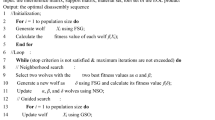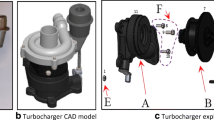Abstract
To improve the disassembly efficiency, cooperative disassembly is essential for complex products. Operator task allocation is a significant challenge for cooperative disassembly sequence planning; however, it has not been studied previously to the best of our knowledge. To deal with this problem, a novel cooperative disassembly sequence and task planning (CDS&TP) method was proposed based on the genetic algorithm. A mathematical model of the CDS&TP problem was constructed based on the product’s disassembly hybrid graph model (DHGM). Focusing on the characteristics of the CDS&TP, a multi-layer chromosome coding method was proposed to describe the node layer and operator constraint layer. Thus, the initial population could be deduced through the node layer and operator constraints relationship rule model, which was proposed to construct the operator constraint and node layers. To obtain the task sequence of each operator and the disassembly time of each sequence, a chromosome fitness calculation formula was presented based on the disassembly set, which is the collection of all of the detachable nodes with a disassembly priority higher than the node. The chromosome evolution rules, such as the selection, crossover, and mutation operators, were redesigned to obtain the (approximate) optimal multiplayer cooperative disassembly sequences and task planning. Finally, a case study was proposed to validate the method.











Similar content being viewed by others
References
Hsu HP (2017) A fuzzy knowledge-based disassembly process planning system based on fuzzy attributed and timed predicate/transition net. IEEE Trans Syst Man Cybern: Syst 47(8):1800–1813
Nowakowski P (2018) A novel, cost efficient identification method for disassembly planning of waste electrical and electronic equipment. J Clean Prod 172:2695–2707
Marconi M, Germani M, Mandolini M, Favi C (2018) Applying data mining technique to disassembly sequence planning: a method to assess effective disassembly time of industrial products. Int J Prod Res 57(2):599–623 1–25
Liu J, Zhou Z, Pham DT, Xu W, Ji C, Liu Q (2017) Robotic disassembly sequence planning using enhanced discrete bees algorithm in remanufacturing. Int J Prod Res 56(9):3134–3151
Zhang XF, Zhang SY (2010) Product cooperative disassembly sequence planning based on branch-and-bound algorithm. Int J Adv Manuf Technol 51(9-12):1139–1147
Ren Y, Zhang C, Zhao F, Xiao H, Tian G (2018) An asynchronous parallel disassembly planning based on genetic algorithm. Eur J Oper Res 269(2):647–660
Oyedepo SO, Olayiwola FR (2011) A study of implementation of preventive maintenance programme in Nigeria power industry–Egbin thermal power plant, case study. Energy Power Eng 3(3):207–220
Wang L, Yu ZW, Han Q, Guo B, Xiong HL (2017) Multi-objective optimization based allocation of heterogeneous spatial crowdsourcing tasks. IEEE Trans Mob Comput 99:1–14
Mishra SK, Puthal D, Sahoo B, Jena SK, Obaidat MS (2017) An adaptive task allocation technique for green cloud computing. J Supercomput 74(1):370–385
Zhao W, Meng Q, Chung PWH (2016) A heuristic distributed task allocation method for multivehicle multitask problems and its application to search and rescue scenario. IEEE Trans Cybern 46(4):902–915
Smith S, Smith G, Chen WH (2012) Disassembly sequence structure graphs: an optimal approach for multiple-target selective disassembly sequence planning. Adv Eng Inform 26(2):306–316
Tseng YJ, Kao HT, Huang FY (2010) Integrated assembly and disassembly sequence planning using a GA approach. Int J Prod Res 48(20):5991–6013
Meng K, Lou P, Peng X, Prybutok V (2016) An improved co-evolutionary algorithm for green manufacturing by integration of recovery option selection and disassembly planning for end-of-life products. Int J Prod Res 54(18):5567–5593
Rickli JL, Camelio JA (2014) Partial disassembly sequencing considering acquired end-of-life product age distributions. Int J Prod Res 52(24):7496–7512
Home DMLS, Sanderson AC (1991) A correct and complete algorithm for the generation of mechanical assembly sequences. RobotAutom IEEE Trans 7(2):228–240
Guo X, Liu S, Zhou M, Tian G (2016) Disassembly Sequence Optimization for Large-Scale Products With Multiresource Constraints Using Scatter Search and Petri Nets. IEEE Trans Cybern 46(11):2435–2446
Seelig L, Schlatter M (2007) Disassembly sequence planning in a disassembly cell context. Robot Comput Integr Manuf 23(6):690–695
Dong T, Zhang L, Tong R, Dong J (2005) A hierarchical approach to disassembly sequence planning for mechanical product. Int J Adv Manuf Technol 30(5-6):507–520
Xia K, Gao L, Li W, Chao KM (2014) Disassembly sequence planning using a Simplified Teaching–Learning-Based Optimization algorithm. Adv Eng Inform 28(4):518–527
Mcgovern SM, Gupta SM (2006) Ant colony optimization for disassembly sequencing with multiple objectives. Int J Adv Manuf Technol 30(5-6):481–496
Zhang H C, Kuo T C (1997) A graph-based disassembly sequence planning for EOL product recycling. Twenty First IEEE/CPMT International Electronics Manufacturing Technology Symposium Proceedings 1997 IEMT Symposium. pp 140-151.
Moore KE, Güngör A (2001) GUPTA S M. Petri net approach to disassembly process planning for products with complex AND/OR precedence relationships. Eur J Oper Res 135(2):428–449
Tang Y, Zhou MC, Gao M (2006) Fuzzy-Petri-net based disassembly planning considering human factors. IEEE Trans Syst Man Cybern Part A: Syst Humans 36(4):718–726
Srinivasan H, GADH R (1998) A geometric algorithm for single selective disassembly using the wave propagation abstraction. Comput Aided Des 30(8):603–613
Garcia MA, Larre A, Lopez B, Oller A. (2000). Reducing the complexity of geometric selective disassembly. Proceedings. 2000 IEEE/RSJ International Conference on Intelligent Robots and Systems. pp 1474-1479.
Chung C, Peng Q (2005) An integrated approach to selective disassembly sequence planning. Robot Comput Integr Manuf 21(4-5):475–485
Li JR, Li PK, Tor SB (2005) An object-oriented intelligent disassembly sequence planner for maintenance. Comput Ind 56(7):699–718
Li W, Xia K, Lu B, Chao KM, Gao L, Yang JX (2013) Selective disassembly planning for waste electrical and electronic equipment with case studies on liquid crystal displays. Robot Comput Integr Manuf 29(4):248–260
Kongar E, Gupta SM (2005) Disassembly sequencing using genetic algorithm. Int J Adv Manuf Technol 30(5-6):497–506
Zhang ZF, Feng YX, Tan JR, Jia WQ, Yi GD (2015) A novel approach for parallel disassembly design based on a hybrid fuzzy-time model. Zhejiang Univ-Sci A (Appl Phys & Eng) 16(9):724–736
Gil P, Pomares J, Diaz SVPC, Candelas F, Torres F (2007) Flexible multi-sensorial system for automatic disassembly using cooperative robots. Int J Comput Integr Manuf 20(8):757–772
Aguinaga I, Borro D, Matey L (2015) Parallel RRT-based path planning for selective disassembly planning. I Int J Adv Manuf Technol 36(11-12):1221–1233
Kara Y (2015) A network-based shortest route model for parallel disassembly line balancing problem. Int J Prod Res 53(6):1849–1865
Chen SF, Oliver JH, Chou SY, Chen LL (1997) Parallel Disassembly by Onion Peeling. J Mech Des 119(2):267–274
Kang JG, Lee DH, Xirouchakis P, Persson JG (2001) Parallel Disassembly Sequencing with Sequence-Dependent Operation Times. CIRP Ann 50(1):343–346
Diaz C (2006) Task planner for a cooperative disassembly robotic system. Inform Control Problems Manuf 163-168.
Zhang XF, Yu G, Hu ZY, Pei CH, Ma GQ (2014) Parallel disassembly sequence planning for complex products based on fuzzy-rough sets. Int J Adv Manuf Technol 72(1-4):231–239
Kim HW, Lee DH (2017) An optimal algorithm for selective disassembly sequencing with sequence-dependent set-ups in parallel disassembly environment. Int J Prod Res 2017(3):1–17
Smith S, Hung PY (2015) A novel selective parallel disassembly planning method for green design[J]. J Eng Des 26(10-12):283–301
Tian YT, Zhang XF, Xu JF, Li ZG (2018) Selective Parallel Disassembly Sequence Planning Method for Remanufacturing. J Comp-Aided Design Comp Graphics 2018(3):531–539
Ren Y, Tian G, Zhao F, Yu D, Zhang C (2017) Selective cooperative disassembly planning based on multi-objective discrete artificial bee colony algorithm. Eng Appl Artif Intell 64:415–431
Pistolesi F, Lazzerini B (2019) TeMA: a tensorial memetic algorithm for many-objective parallel disassembly sequence planning in product refurbishment. IEEE Trans Ind Inform 15(6):3743–3753
Zha XF, Lim SYE (2000) Assembly/disassembly task planning and simulation using expert Petri nets. Int J Prod Res 38(15):3639–3676
Akbari A, Muhayyuddin RJ (2018) Knowledge-oriented task and motion planning for multiple mobile robots. J Exp Theor Artif Intell 31(1):137–162
Gao J, Sun L, Gen M (2008) A hybrid genetic and variable neighborhood descent algorithm for flexible job shop scheduling problems. Comput Oper Res 35(9):2892–2907
Deliktas D, Torkul O, Ustun O (2017) A flexible job shop cell scheduling with sequence-dependent family setup times and intercellular transportation times using conic scalarization method. Int Trans Oper Res 26(6):2410–2431 0:1-22
Rahmani Hosseinabadi AA, Vahidi J, Saemi B, Sangaiah AK, Elhoseny M (2018) Extended Genetic Algorithm for solving open-shop scheduling problem. Soft Comput 23(13):5099–5116 pp. 1-18
Cao Z, Zhou L, Hu B, Lin C (2019) An adaptive scheduling algorithm for dynamic jobs for dealing with the flexible job shop scheduling problem. Bus Inf Syst Eng 61(3):299–309
Lu H, Niu R, Liu J, Zhu Z (2013) A chaotic non-dominated sorting genetic algorithm for the multi-objective automatic test task scheduling problem. Appl Soft Comput 13(5):2790–2802
Pezzella F, Morganti G, Ciaschetti G (2008) A genetic algorithm for the flexible job-shop scheduling problem. Comput Oper Res 35(10):3202–3212
Gao J, Gen M, Sun L, Zhao X (2007) A hybrid of genetic algorithm and bottleneck shifting for multiobjective flexible job shop scheduling problems. Comput Ind Eng 53(1):149–162
Tian GD, Ren YP, Feng YX, Zhou MC, Zhang HH, Tan JR (2019) Modeling and planning for dual-objective selective disassembly using and/or graph and discrete artificial bee colony. IEEE Trans Ind Inform 15(4):2456–2468
Rui X, Mingqing X, Jinjun C, Xinhua F (2007) Optimizing the multi-UUT parallel test task scheduling based on multi-objective GASA. 2007 8th International Conference on Electronic Measurement and Instruments.pp. 839-844.
Wang H, Jiang Z, Zhang X, Wang Y, Wang Y (2017) A fault feature characterization based method for remanufacturing process planning optimization. J Clean Prod 161:708–719
Seo KK, Park JH, Jang DS (2001) Optimal disassembly sequence using genetic algorithms considering economic and environmental aspects. Int J Adv Manuf Technol 18(5):371–380
Acknowledgments
We thank LetPub (www.letpub.com) for its linguistic assistance during the preparation of this manuscript.
Funding
This research is supported by the National Natural Science Foundation of China (No. 51565044), the Inner Mongolia Natural Science Foundation of China (No. 2017MS (LH) 0510), and the Program for Young Talents of Science and Technology in Universities of Inner Mongolia Autonomous Region (NJYT-17-B08).
Author information
Authors and Affiliations
Corresponding authors
Additional information
Publisher’s note
Springer Nature remains neutral with regard to jurisdictional claims in published maps and institutional affiliations.
Appendix
Appendix

Fig. 12

Fig. 13

Fig. 14
Rights and permissions
About this article
Cite this article
Tian, Y., Zhang, X., Liu, Z. et al. Product cooperative disassembly sequence and task planning based on genetic algorithm. Int J Adv Manuf Technol 105, 2103–2120 (2019). https://doi.org/10.1007/s00170-019-04241-9
Received:
Accepted:
Published:
Issue Date:
DOI: https://doi.org/10.1007/s00170-019-04241-9




